1996 CHEVROLET CAVALIER instrument panel
[x] Cancel search: instrument panelPage 217 of 372
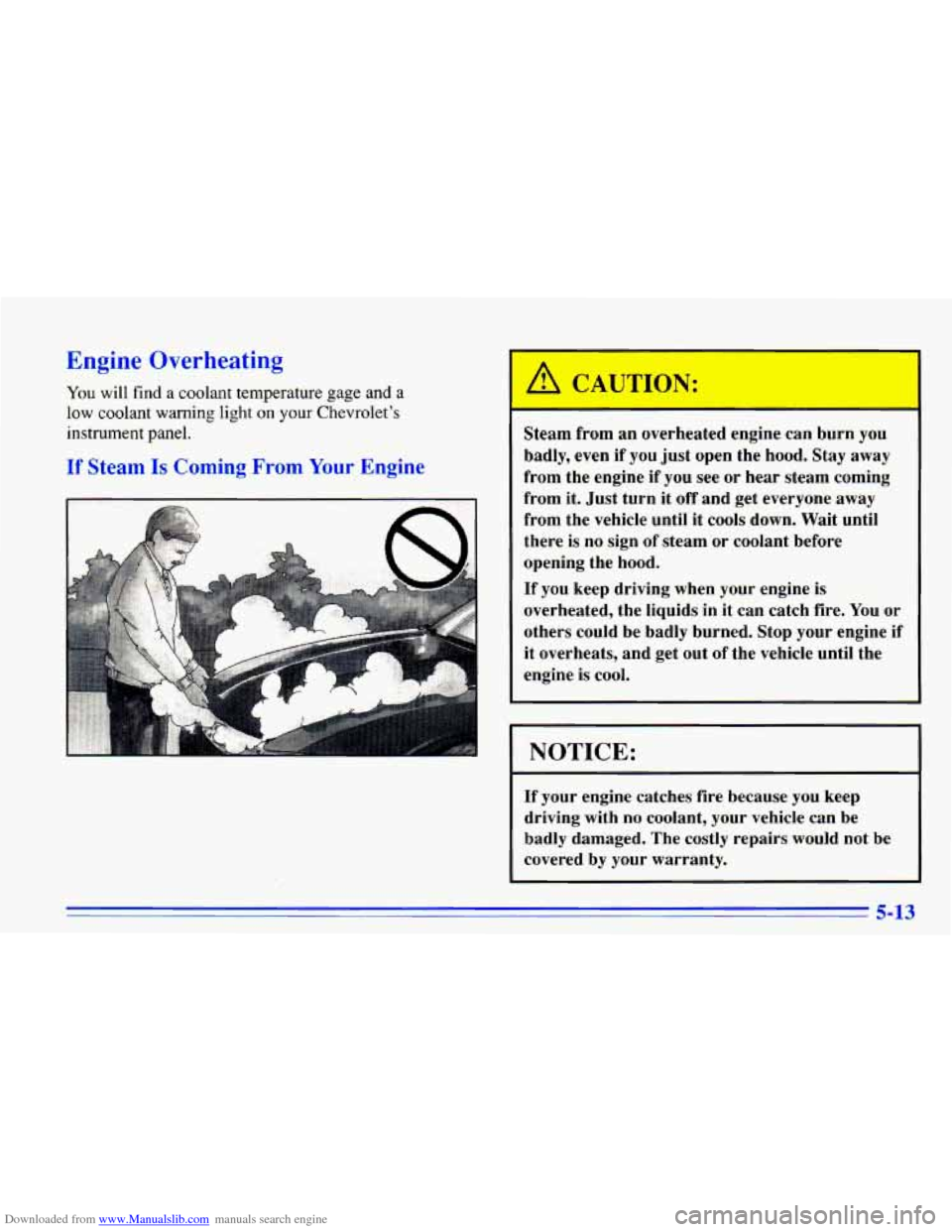
Downloaded from www.Manualslib.com manuals search engine Engine Overheating
You will find a coolant temperature gage and a
low coolant warning light on your Chevrolet’s
instrument panel. Steam
from an overheated engine can burn you
badly, even if you just open the hood. Stay away
from the engine if you
see or hear steam coming
from it. Just turn it
off and get everyone away
from the vehicle until it cools down. Wait until
there is no sign of steam or coolant before
opening the hood.
If you keep driving when your engine
is
overheated, the liquids in it can catch fire. You or
others could be badly burned. Stop your engine
if
it overheats, and get out of the vehicle until the
engine is cool.
I NOTICE:
If your engine catches fire because you keep
driving with no coolant, your vehicle can be
badly damaged. The costly repairs would not be
covered by your warranty.
5-13
Page 240 of 372

Downloaded from www.Manualslib.com manuals search engine You can be injured and your vehicle could be
damaged if you try to do service work on a
vehicle without knowing enough about it.
0 Be sure you have sufficient knowledge,
experience, and the proper replacement
parts and tools before you attempt any
vehicle maintenance task.
0 Be sure to use the proper nuts, bolts and
other fasteners. “English” and “metric”
fasteners can be easily confused.
If you use
the wrong fasteners, parts can later break or fall off.
You could be hurt.
Fuel
Use regular unleaded gasoline rated at 87 octane or higher.
At a
minimum, it should meet specifications ASTM D4814
in the United States and CGSB 3.5-M93 in Canada.
Improved gasoline specifications have been developed by
the American Automobile Manufacturers Association
(AAMA) for better vehicle performance and engine ,
protection. Gasolines meeting the AAMA specification could provide improved driveability and emission control
system protection compared to other gasolines.
Be sure the posted octane is at least 87.
If the octane is
less than 87, you may get
a heavy knocking noise when
you drive.
If it’s bad enough, it can damage your engine.
If you’re using fuel rated at
87 octane or higher and you
still hear heavy knocking, your engine needs service.
But don’t worry
if you hear a little pinging noise when
you’re accelerating or driving up a hill. That’s normal,
and you don’t have to buy a higher octane fuel to get rid
of pinging. It’s the heavy, constant knock that means
you have a problem.
If your vehicle is certified to meet California Emission
Standards (indicated on the underhood tune-up label), it
is designed to operate on fuels that meet California
specifications. If such fuels
are not available in states
adopting California emissions standards, your vehicle
will operate satisfactorily on fuels meeting federal
specifications, but ‘emission control system performance
may be affected. The malfunction indicator lamp on
your instrument panel may
turn on and/or your vehicle
may fail a smog-check test.
If this occurs, return to your
authorized Chevrolet dealer for diagnosis to determine
the cause of failure.
In the event it is determined that the;
cause of the condition is the type of fuels used, repairs
may not be covered by your warranty.
6-2
Page 241 of 372
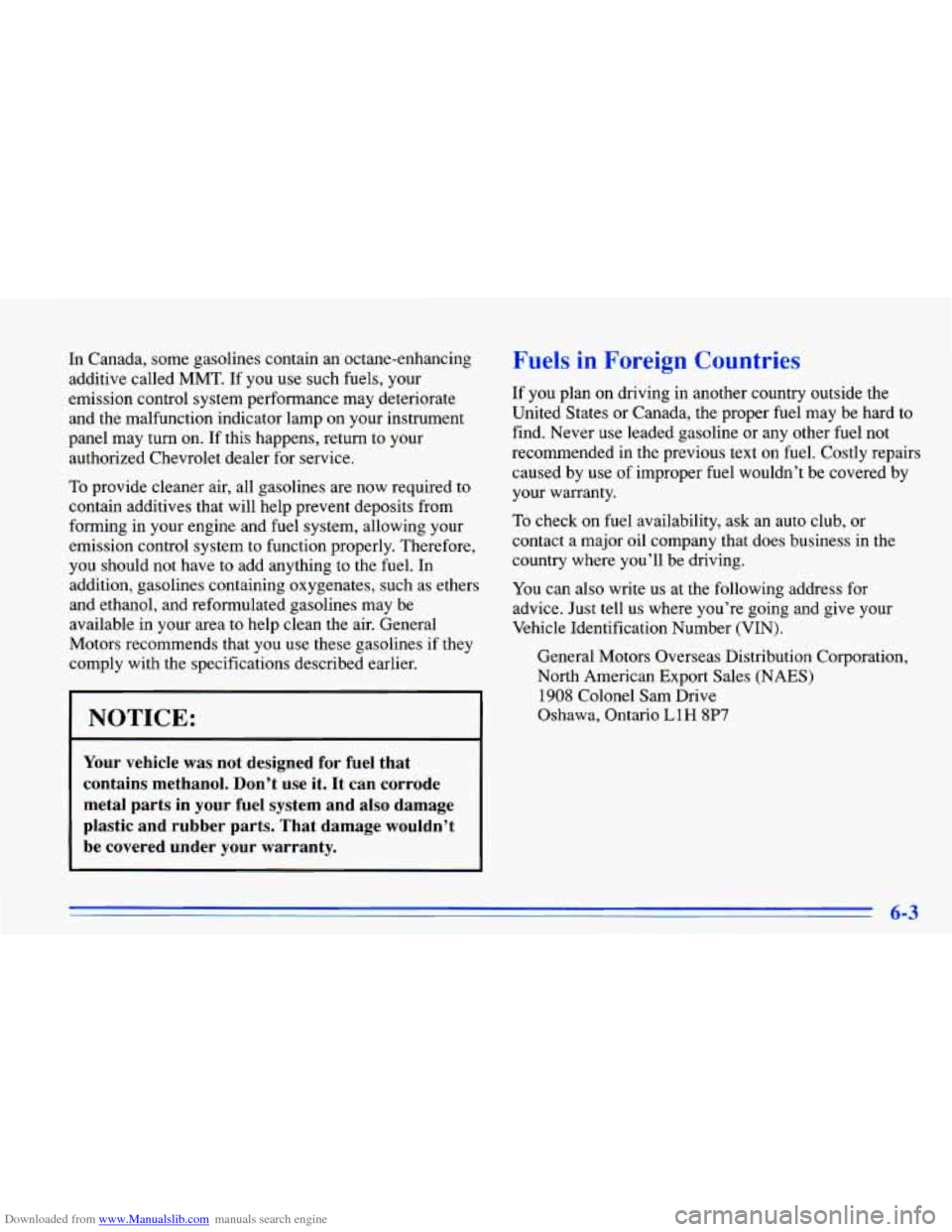
Downloaded from www.Manualslib.com manuals search engine In Canada, some gasolines contain an octane-enhancing
additive called
MMT. If you use such fuels, your
emission control system performance may deteriorate
and the malfunction indicator lamp on your instrument
panel may turn on.
If this happens, return to your
authorized Chevrolet dealer for service.
To provide cleaner air, all gasolines are now required to
contain additives that will help prevent deposits from
forming in your engine and fuel system, allowing your
emission control system to function properly. Therefore,
you should not have to add anything to the fuel. In
addition, gasolines containing oxygenates, such as ethers
and ethanol, and reformulated gasolines may be
available in your area to help clean the air. General
Motors recommends that you use these gasolines if they
c~ lply with the specifications described earlier.
7- I
I NOTICE:
Your vehicle was not designed for fuel that
contains methanol. Don’t use it. It can corrode
metal parts in your fuel system and
also damage
plastic and rubber parts. That damage wouldn’t
be covered under your warranty.
Fuels in Foreign Countries
If you plan on driving in another country outside the
United States or Canada, the proper fuel may be hard to
find. Never use leaded gasoline or any other fuel not
recommended in the previous text on fuel. Costly repairs
caused by use of improper fuel wouldn’t be covered by
your warranty.
To check on fuel availability, ask an auto club, or
contact a major oil company that does business in the
country where you’ll be driving.
You can also write us at the following address for
advice. Just tell us where you’re going and give your
Vehicle Identification Number (VIN).
General Motors Overseas Distribution Corporation,
North American Export Sales (NAES)
1908 Colonel Sam Drive
Oshawa, Ontario
LlH 8P7
6-3
Page 248 of 372
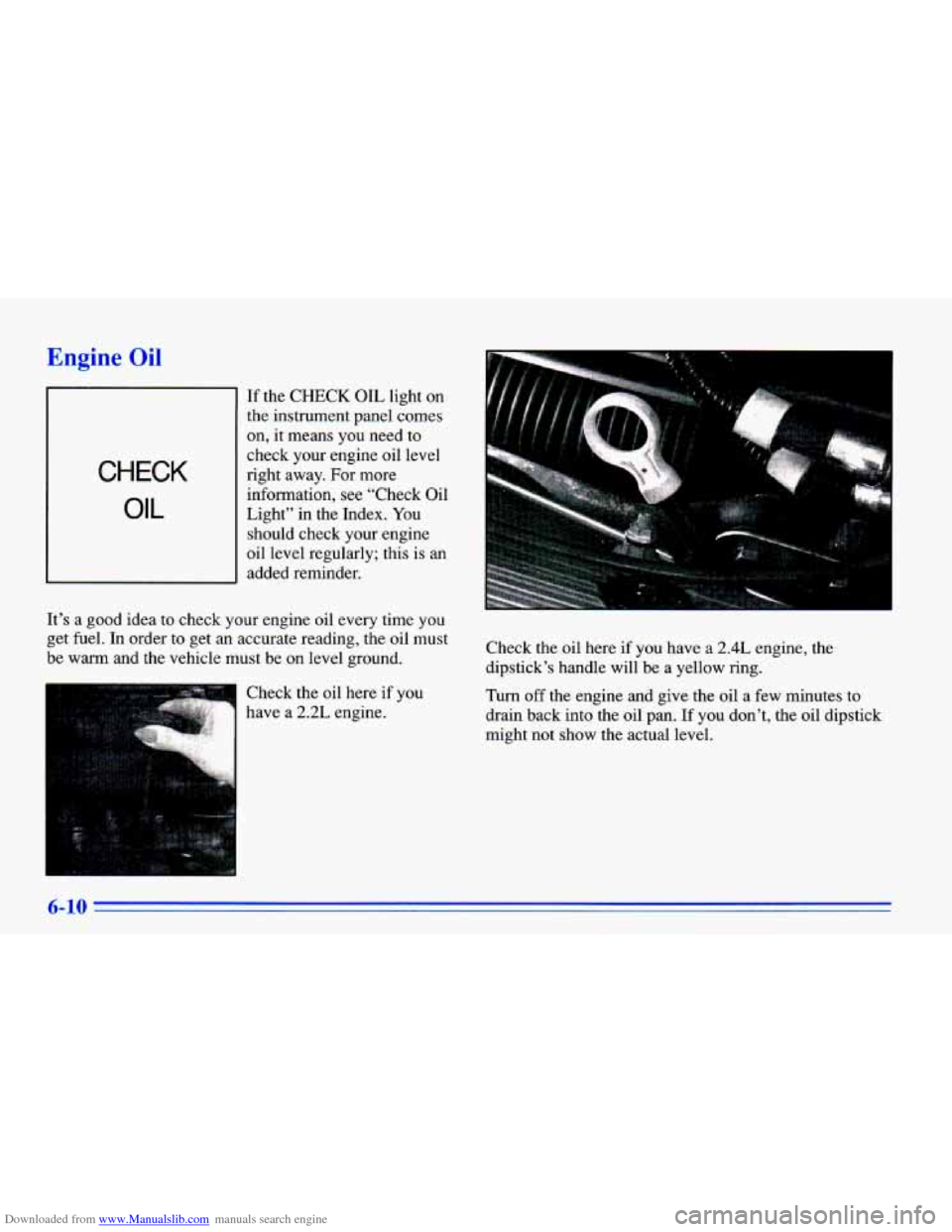
Downloaded from www.Manualslib.com manuals search engine Engine Oil
CHECK
OIL
If the CHECK OIL light on
the instrument panel comes
on, it means you need to
check your engine oil level
right away.
For more
information,
see “Check Oil
Light” in the Index. You
should check your engine
oil level regularly; this is an
added reminder.
It’s a good idea to check your engine oil every time you
get fuel. In order to get an accurate reading, the oil must
be warm and the vehicle must be on level ground.
Check the
oil here if you
have a 2.2L engine. Check the
oil here if you have a
2.4L engine, the
dipstick’s handle will be a yellow ring.
Turn off the engine and give the oil a few minutes to
drain back into the oil pan. If you don’t, the oil dipstick
might not show the actual level.
Page 284 of 372
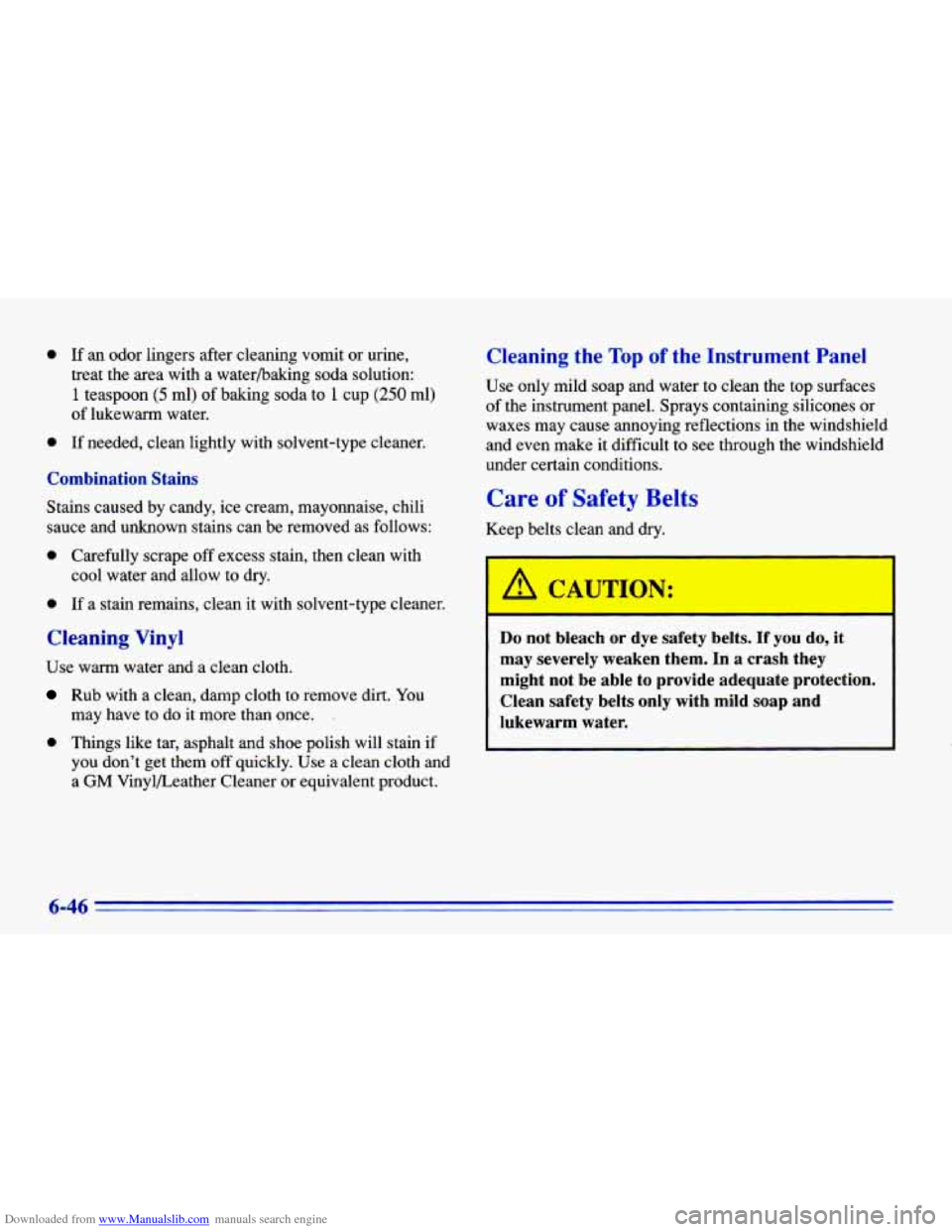
Downloaded from www.Manualslib.com manuals search engine 0 If an odor lingers after cleaning vomit or urine,
treat the area with a waterbaking soda solution:
1 teaspoon (5 ml) of baking soda to 1 cup (250 ml)
of lukewarm water.
0 If needed, clean lightly with solvent-type cleaner.
Combination Stains
Stains caused by candy, ice cream, mayonnaise, chili
sauce and unknown stains can
be removed as follows:
0 Carefully scrape off excess stain, then clean with
0 If a stain remains, clean it with solvent-type cleaner.
cool water and allow to dry.
Cleaning Vinyl
Use warm water and
a clean cloth.
Rub with a clean, damp cloth to remove dirt. You
may have to do it more than once. .
0 Things like tar, asphalt and shoe polish will stain if
you don’t get them off quickly. Use a clean cloth and
a
GM VinylLeather Cleaner or equivalent product.
Cleaning the Top of the Instrument Panel
Use only mild soap and water to clean the top surfaces
of the instrument panel. Sprays containing silicones or
waxes may cause annoying reflections in the windshield
and even make it difficult to see through the windshield
under certain conditions.
Care of Safety Belts
Keep belts clean and dry.
I A CAUTION: I
Do not bleach or dye safety belts. If you do, it
may severely weaken them.
In a crash they
might not be able to provide adequate protection.
Clean safety belts only with mild soap and
lukewarm water.
Page 289 of 372
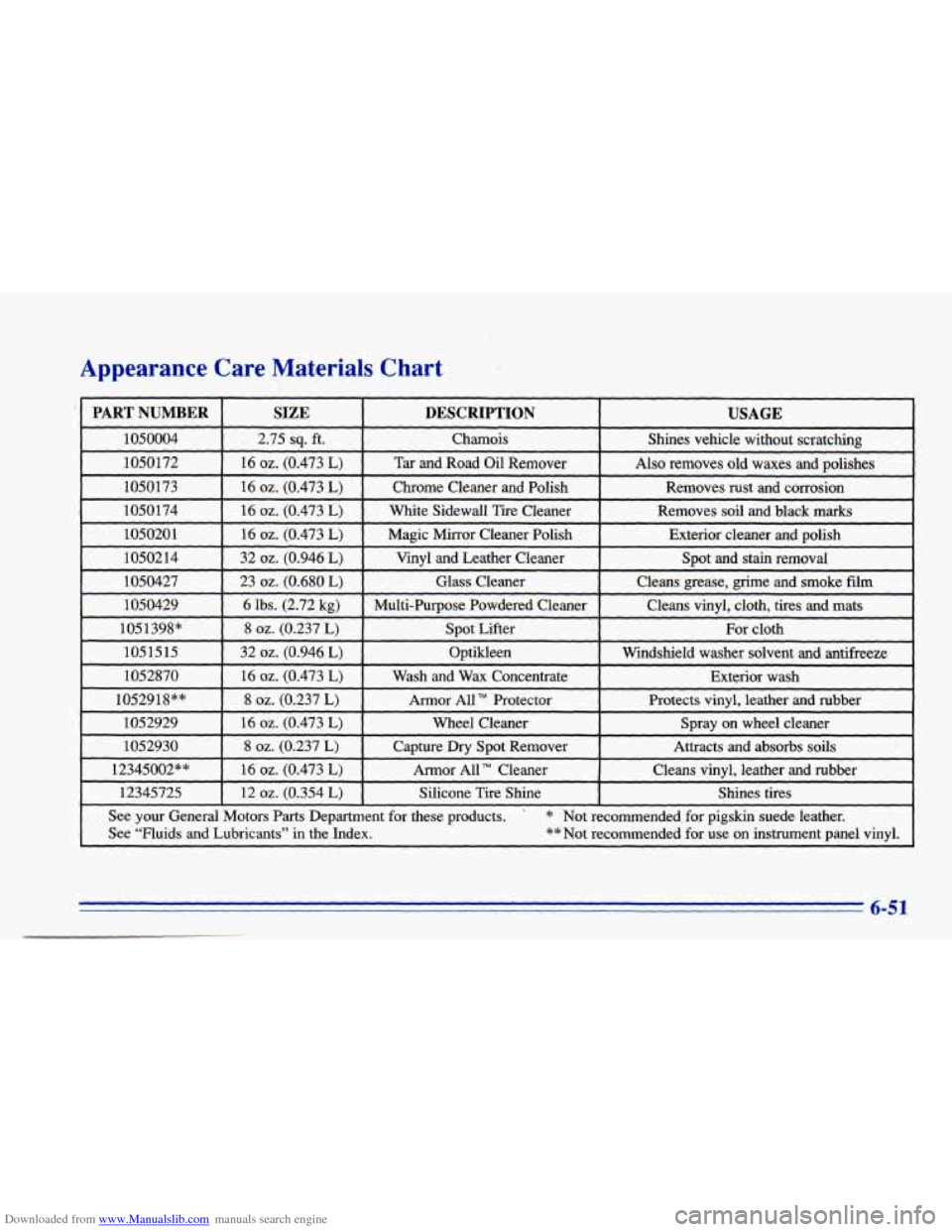
Downloaded from www.Manualslib.com manuals search engine Appearance Care Materials Chart
1052929 16 02. (0.473 L) Wheel Cleaner
Spray on wheel cleaner
1052930 8 oz. (0.237 L) Capture Dry Spot Remover Attracts and absorbs soils
12345002** 16 oz. (0.473 L) Armor All” Cleaner Cleans Vinyl, leather and rubber
12345725 12 oz. (0.354 L) Silicone Tire Shine Shines tires
See your General Motors Parts Department for these products. ’ * Not recommended. for pigskin suede leather.
See “Fluids and Lubricants”
in the Index. ** Not recommended for use on instrument panel vinyl.
6-51
Page 290 of 372
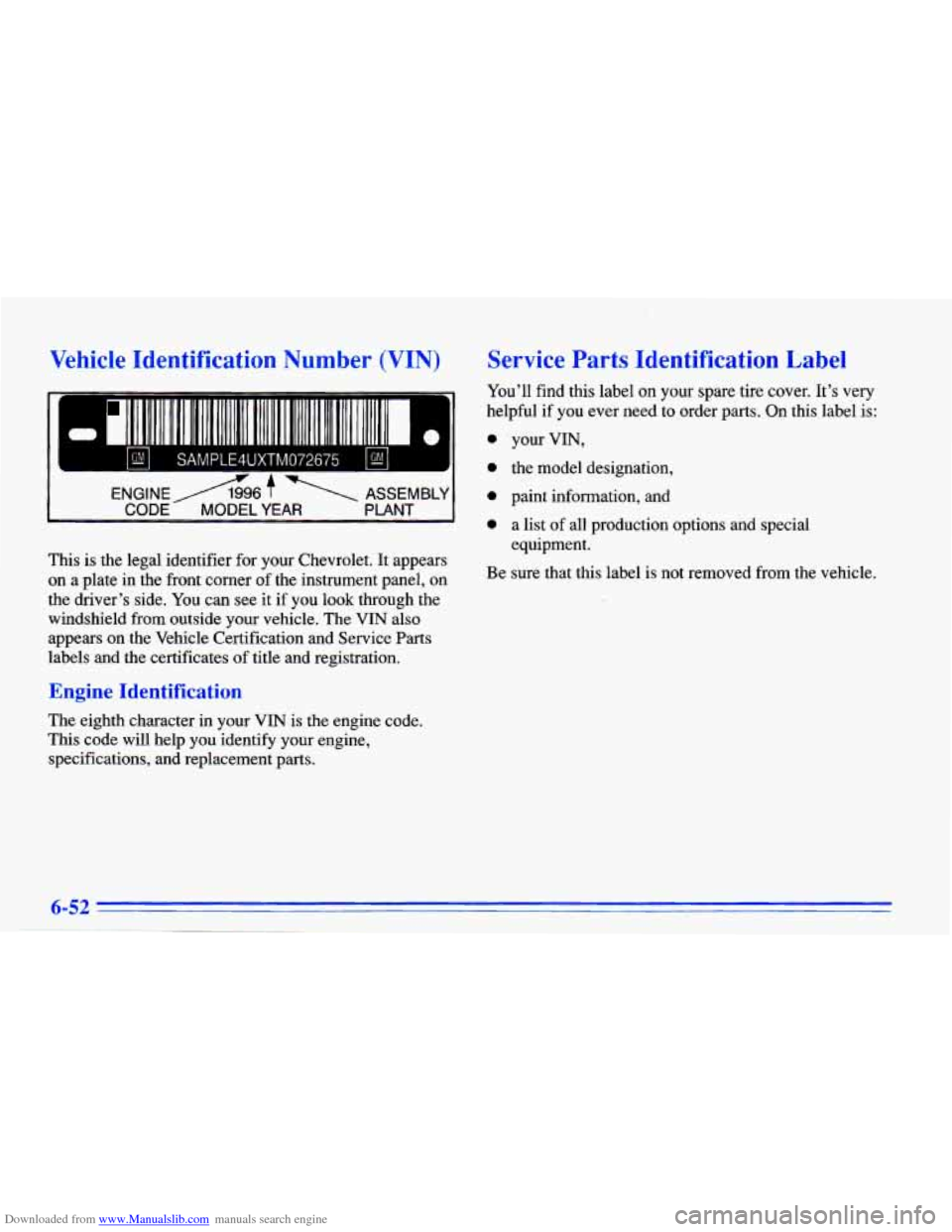
Downloaded from www.Manualslib.com manuals search engine Vehicle Identification Number (VIN)
r
- Dl I1 11111111 1111 111 111111 111 111111II 111111111111 111111111 111 0
SAMPLE4UXTM072675 L A
This is the legal identifier for your Chevrolet. It appears
on a plate
in the front comer of the instrument panel, on
the driver’s side. You can see it if you look through the
windshield from outside your vehicle. The
VIN also
appears on the Vehicle Certification and Service Parts
labels and the certificates of title and registration.
Engine Identification
The eighth character in your VIN is the engine code.
This code will help you identify your engine, specifications, and replacement parts.
Service Parts Identification Label
You’ll find this label on your spare tire cover. It’s very
helpful if you ever need to order parts. On this label
is:
a
0
0
a
your VIN,
the model designation,
paint information, and a list of all production options and special
equipment.
Be sure that this label is not removed from the vehicle.
6-52
Page 291 of 372
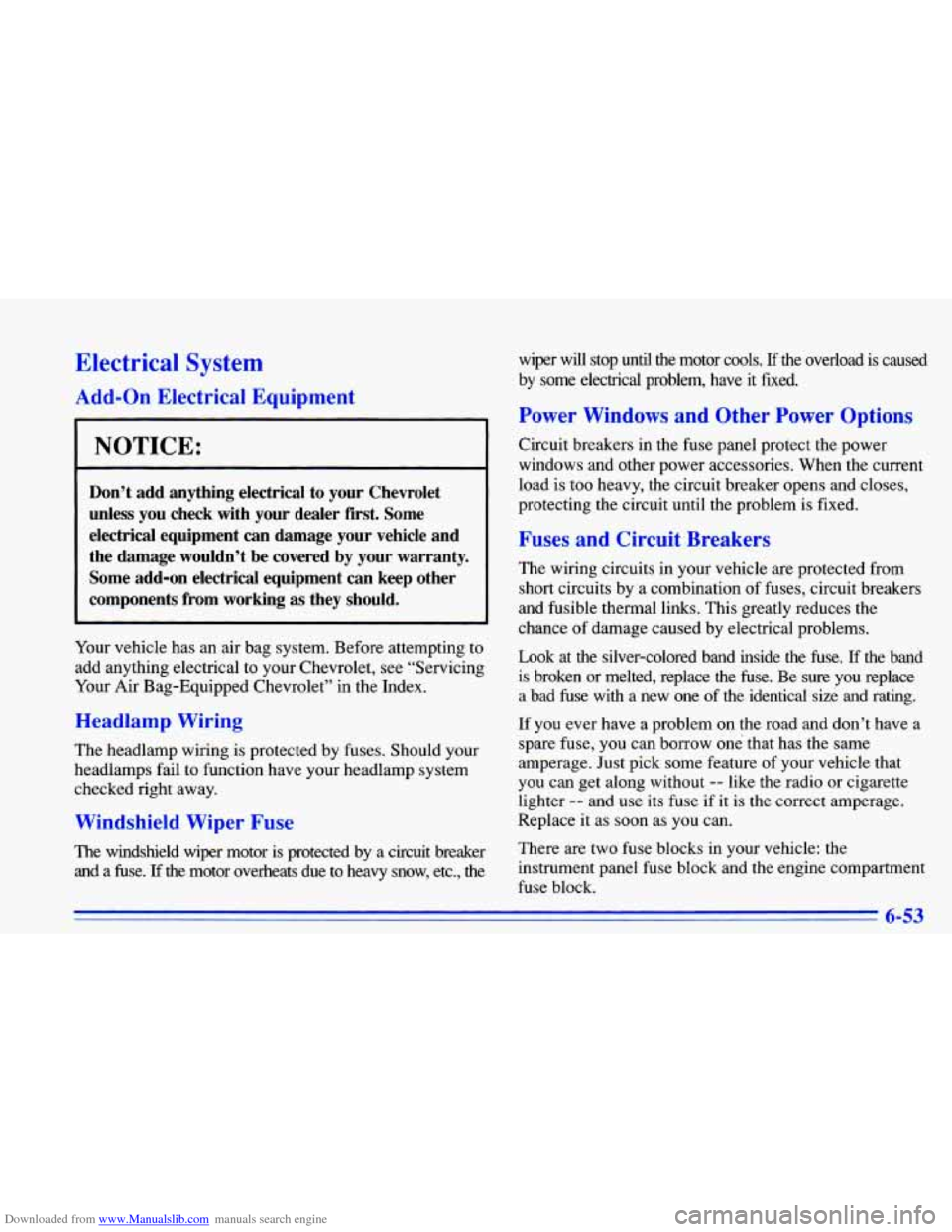
Downloaded from www.Manualslib.com manuals search engine Electrical System
Add-on Electrical Equipment
NOTICE:
Don’t add anything electrical to your Chevrolet
unless you check with your dealer first. Some
electrical equipment can damage your vehicle and
the damage wouldn’t be covered by your warranty. Some add-on electrical equipment can keep other
components from working
as they should.
Your vehicle has an air bag system. Before attempting to
add anything electrical to your Chevrolet, see “Servicing
Your
Air Bag-Equipped Chevrolet” in the Index.
Headlamp Wiring
The headlamp wiring is protected by fuses. Should your
headlamps fail to function have your headlamp system
checked right away.
Windshield Wiper Fuse
The windshield wiper motor is protected by a circuit breaker
and a fuse.
If the motor overheats due to heavy snow, etc., the
wiper will stop until the moIor cools. If the overload is caused
by some electrical problem,
have it fixed.
Power Windows and Other Power Options
Circuit breakers in the fuse panel protect the power
windows and other power accessories. When the current
load is too heavy, the circuit breaker opens and closes,
protecting the circuit until the problem
is fixed.
Fuses and Circuit Breakers
The wiring circuits in your vehicle are protected from
short circuits by a combination of fuses, circuit breakers
and fusible thermal links. This greatly reduces the
chance of damage caused by electrical problems.
Look at the silver-colored band inside the fuse.
If the band
is broken or melted, replace the fuse. Be sure you replace
a bad fuse with a new one of the identical
size and rating.
If you ever have a problem on the road and don’t have a
spare fuse, you can borrow one that has the same
amperage. Just pick some feature of your vehicle that
you can get along without -- like the radio or cigarette
lighter
-- and use its fuse if it is the correct amperage.
Replace
it as soon as you can.
There are two fuse blocks in your vehicle: the
instrument panel fuse block and the engine compartment
fuse block.
6-53